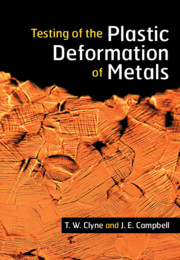Book contents
- Testing of the Plastic Deformation of Metals
- Reviews
- Testing of the Plastic Deformation of Metals
- Copyright page
- Contents
- Preface
- Nomenclature
- 1 General Introduction
- 2 Stresses, Strains and Elasticity
- 3 Continuum Plasticity
- 4 Mechanisms of Plastic Deformation in Metals
- 5 Tensile Testing
- 6 Compressive Testing
- 7 Hardness Testing
- 8 Indentation Plastometry
- 9 Nanoindentation and Micropillar Compression
- 10 Other Testing Geometries and Conditions
- Index
- References
10 - Other Testing Geometries and Conditions
Published online by Cambridge University Press: 24 May 2021
- Testing of the Plastic Deformation of Metals
- Reviews
- Testing of the Plastic Deformation of Metals
- Copyright page
- Contents
- Preface
- Nomenclature
- 1 General Introduction
- 2 Stresses, Strains and Elasticity
- 3 Continuum Plasticity
- 4 Mechanisms of Plastic Deformation in Metals
- 5 Tensile Testing
- 6 Compressive Testing
- 7 Hardness Testing
- 8 Indentation Plastometry
- 9 Nanoindentation and Micropillar Compression
- 10 Other Testing Geometries and Conditions
- Index
- References
Summary
Various loading geometries can be used for mechanical testing aimed at plasticity characterization. The simplest involve uniform stress states of uniaxial tension or compression, while the other common configuration is indentation, which creates complex and changing (2-D or 3-D) stress fields that are not amenable to simple analysis. These tests are covered in earlier chapters. However, other types of geometry can be employed, which may offer certain advantages. For example, bending or torsion of beams can be convenient experimentally and, while the associated stress fields are not uniform, they are relatively simple and may be suitable for analytical treatment. In fact, beam bending, in particular, offers potential for obtaining material properties via iterative FEM, in a similar way to indentation plastometry. Other geometries, such as those involving hollow tubes, may be relevant to particular types of application and expected (plastic) failure modes (such as buckling). There are also various tests involving temporal effects. Prolonged application of constant, uniform stress, leading to creep deformation, is covered in Chapter 5. However, again with a view to specific applications, the applied load may be cycled with a certain frequency, rather than being held constant or increased monotonically. While such (fatigue) testing is sometimes focused on propagation of well-defined cracks, there is also interest in progressive damage that essentially arises from plastic deformation. Finally, some types of test are designed to create high strain rates, under which plasticity often takes place rather differently (because, as outlined in Chapter 3, the mechanisms involved exhibit a time dependence). This chapter covers all of these testing variants.
- Type
- Chapter
- Information
- Testing of the Plastic Deformation of Metals , pp. 219 - 269Publisher: Cambridge University PressPrint publication year: 2021



